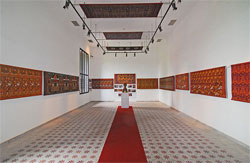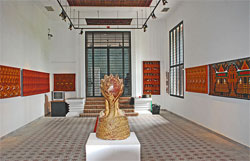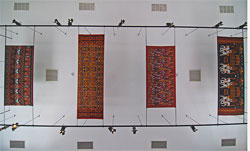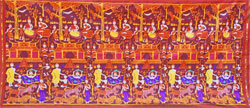| 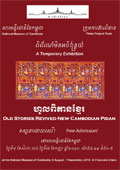
Old Stories Revied - New Cambodian Pidan
August 8 - September 7, 2010
What is a pidan?
A pidan, or ‘bitan’ as it
is often pronounced, is a very special, elaborately designed pictorial
silk textile used in Buddhist temples. The word pidan can be translated
as ‘ceiling’ or ‘canopy’ and these textiles
were often hung over, or near, the principal Buddha image in a temple.
A pidan is distinguished from other silk textiles
by its design of narrative scenes, which often relate to Buddhism.
A pidan with religious scenes is never worn as clothing. Whereas
most decorative Khmer craft, especially the decorative work in the
structure of temples, is carried out by men, the weaving of ceremonial
pidan was the work of women.
The designs are produced by a painstaking method
called ‘hol’ in the Khmer language, and known elsewhere
by the term ‘íkat’. This process creates the
desired pattern by tying the threads prior to dyeing. For each colour
the threads must have new ties added, and/or the previous ones removed.
Only after all the dyeing is finished can the weaving begin. The
weaver must carefully align each new weft thread as she weaves,
or the pattern will not be clear. The process thus involves much
preparation and clear forethought of the design.
The techniques used to weave these pictorial pidan
were rarely practiced even before the Khmer Rouge regime. The regime
prohibited silk weaving entirely so pidan weaving also ceased. The
techniques involved were retained only in the minds of a few and
so its revival is both important and commercially precarious.
The revival of pidan
The aim of the Pidan Project Team is to show new
pidan in a permanent exhibition of this revived craft. It is important
that the heritage, beauty, religious beliefs and the stories contained
in pidan are understood and appreciated by the younger generations
of Khmer, and by visitors to Cambodia
| 


